CIP and Ethernet/IP Error Decoder
This article is intended to help the user identify the causes of error codes generated when connecting EtherNet/IP devices to OMRON PLC and MAC controllers such as CS1, CJ2, CJ1, NX and NJ products. Detailed troubleshooting procedures for common errors are also provided.
Implicit Messaging
1. Reading the Error Code with Network Configurator for Ethernet/IP
- Go online with the OMRON Network Configurator for EtherNet/IP.

- Upload the parameters from the PLC / MAC if the configuration in the EtherNet/IP module is different from the configuration in the Network Configurator for EtherNet/IP by right clicking on the PLC / MAC, and selecting Parameter / Upload.
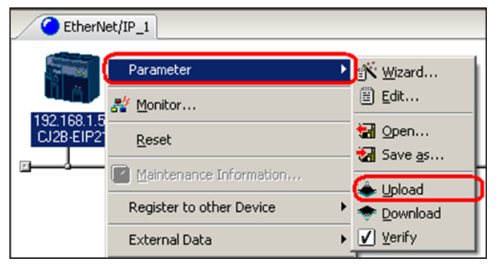
- Right Click on the PLC / MAC and select Monitor.
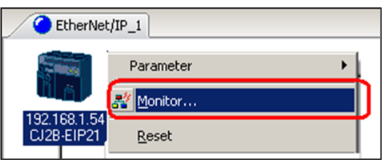
- Go to the Connection tab. The detailed error code for each device is shown in Status. Nodes with communications errors will be shown with a red circle next to the node. Refer to the error code list in Section 3 of this document for the specific error information.
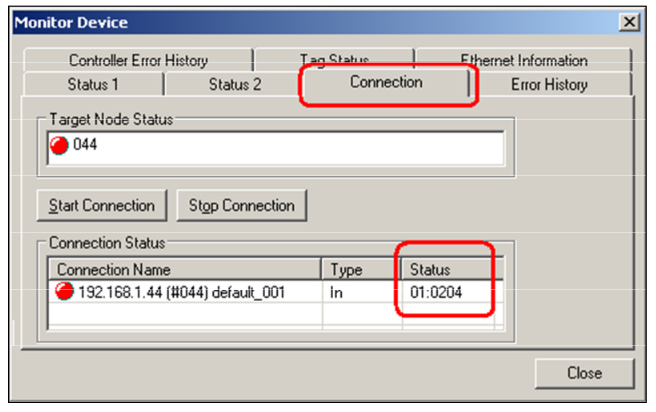
2. Reading the Error Code with Sysmac Studio
- Go online with Sysmac Studio with the current NJ Project. If necessary, upload the project from the NJ to ensure that the project in Sysmac Studio is current.

- Click Tools / EtherNet/IP Connection Settings.
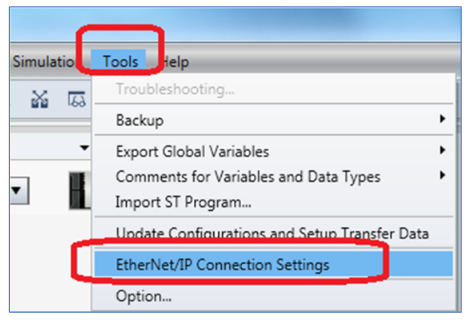
- Right Click on the appropriate EtherNet/IP module or build in EtherNet/IP Port, and select Monitor.

- Go to the Connection Status tab. The detailed error code for each device is shown in Status. Nodes with communications errors will be shown with a red circle next to the node. Refer to the error code list in Section 3 of this document for the specific error information.

3. Error Code List
Information
Error codes shown in bold have troubleshooting procedures in section 4.
| Error Code | Description |
|---|---|
| 01:0100 | Connection in use or duplicate forward open |
| 01:0103 | Transport class and trigger combination not supported |
| 01:0106 | Ownership Conflict |
| 01:0107 | Target connection not found |
| 01:0108 | Invalid network connection parameter |
| 01:0109 | Invalid connection size |
| 01:0110 | Target for connection not configured |
| 01:0111 | RPI not supported |
| 01:0113 | Out of connections |
| 01:0114 | Vendor ID or Product Code mismatch |
| 01:0115 | Product Type Mismatch |
| 01:0116 | Revision Mismatch |
| 01:0117 | Invalid Produced or Consumed application path |
| 01:0118 | Invalid or inconsistent configuration application path |
| 01:0119 | Non-Listen only connection not opened |
| 01:011A | Target object out of connections |
| 01:011B | RPI is smaller than the production inhibit time |
| 01:011C | Transport Class Not Supported |
| 01:011D | Production Trigger Not Supported |
| 01:011E | Direction Not Supported |
| 01:011F | Invalid Originator to Target Network Connection FIXVAR |
| 01:0120 | Invalid Target to Originator Network Connection FIXVAR |
| 01:0121 | Invalid Originator to Target Network Connection Priority |
| 01:0122 | Invalid Target to Originator Network Connection Priority |
| 01:0123 | Invalid Originator to Target Network Connection Type |
| 01:0124 | Invalid Target to Originator Network Connection Type |
| 01:0125 | Invalid Originator to Target Network Connection Redundant_Owner |
| 01:0126 | Invalid Configuration Size |
| 01:0127 | Invalid Originator to Target Size |
| 01:0128 | Invalid Target to Originator Size |
| 01:0129 | Invalid Configuration Application Path |
| 01:012A | Invalid Consuming Application Path |
| 01:012B | Invalid Producing Application Path |
| 01:012C | Configuration Symbol Does Not Exist |
| 01:012D | Consuming Symbol Does Not Exist |
| 01:012E | Producing Symbol Does Not Exist |
| 01:012F | Inconsistent Application Path Combination |
| 01:0130 | Inconsistent Consume Data Format |
| 01:0131 | Inconsistent Produce Data Format |
| 01:0132 | Null Forward Open Function Not Supported |
| 01:0133 | Connection Timeout Multiplier Not Acceptable |
| 01:0203 | Connection timed out |
| 01:0204 | Unconnected request timed out |
| 01:0205 | Parameter error in unconnected request service |
| 01:0206 | Message too large for unconnected send service |
| 01:0207 | Unconnected acknowledgement without reply |
| 01:0301 | No buffer memory available |
| 01:0302 | Network bandwidth not available for data |
| 01:0303 | No consumed connection ID filter available |
| 01:0304 | Not configured to send scheduled priority data |
| 01:0305 | Schedule signature mismatch |
| 01:0306 | Schedule signature validation not possible |
| 01:0311 | Port not available |
| 01:0312 | Link address not valid |
| 01:0315 | Invalid segment in connection path |
| 01:0316 | Error in Forward Close service connection path |
| 01:0317 | Scheduling not specified |
| 01:0318 | Link address to self invalid |
| 01:0319 | Secondary resource unavailable |
| 01:031A | Rack connection already established |
| 01:031B | Module connection already established |
| 01:031C | Miscellaneous |
| 01:031D | Redundant connection mismatch |
| 01:031E | No more user configurable link consumer resources available in the producing module |
| 01:031F | No more user configurable link consumer resources available in the producing module |
| 01:0800 | Network link in path to module is offline |
| 01:0810 | No target application data available |
| 01:0811 | No originator application data available |
4. Troubleshooting common error codes
EDS Differences: 01:0114, 01:0115, and 01:0116
EDS file differences: Error codes 01:0114, 01:0115, and 01:0116, are caused by differences in the Identity Object between the .eds file installed in the Network Configurator for EtherNet/IP and the actual hardware device. To correct these errors, read the actual value of the parameters from the device, and modify the .eds file (using Notepad) to match the hardware device.
- Using the Network Configurator for EtherNet/IP, select Tools / Setup Parameters. The Network Configurator for EtherNet/IP must be online to select this menu option.
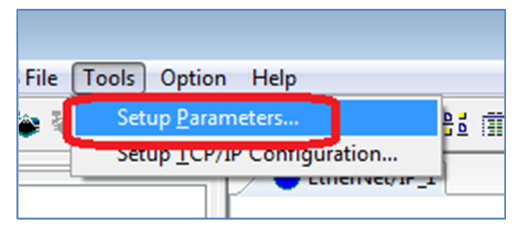
- Using the Setup Parameter tool, read the value of each of the 4 parameters shown, and modify the .eds file for the device to match the values read from the device. To read the data, send the messages to the IP Address of the device, using a service of Get Attribute Single. Refer to the table below for Class, Instance, and Attribute information.


-
Response to VendCode: The response to reading Attribute 1 will be a hexadecimal number, which is byte swapped. Example: 2F00 = VendCode 47.
-
Response to ProdType: The response to reading Attribute 2 will be a hexadecimal number, which is byte swapped. Example: 0700 = ProdType 7.
-
Response to ProdCode: The response to Attribute 3 will be a hexadecimal number, which is byte swapped. Example: 5104 = VendCode 1105.
-
Response to MajRev/MinRev: The response to Attribute 4 will be 2 digits of MajRev in hexadecimal and 2 digits of MinRev in hexadecimal. Example: 0201 = MajRev 02, MinRev 01.
- The Device section of the .eds file should be modified to match the values read from the parameters, as shown below.
[Device]
VendCode = 47;
VendName = "OMRON Corporation";
ProdType = 7;
ProdTypeStr = "General Purpose Discrete I/O";
ProdCode = 1105;
MajRev = 2;
MinRev = 1;
ProdName = "ERT1-MD32SLH-1"; - After making the changes, save the file, delete the device from the product tree in the Network Configurator for EtherNet/IP, and remove any instances of the device in the network diagram. Reload the .eds file and complete the connections.
IO Size Mismatches: 01:0109, 01:0127, 01:0128 and 01:031C
IO Size Mismatches: Error codes 01:0109, 01:0127, 01:0128 and sometimes 01:031C are caused by differences in the produced or consumed data size specified in the connection to a device, compared to the actual assembly sizes of the device. To correct these errors, read the actual produced and consumed assembly data from the device, determine the size from the response data, and modify the connection size.
- Using the Connection information for the device, determine the produced and consumed assembly numbers for the device. Shown below are assemblies 104 and 101.
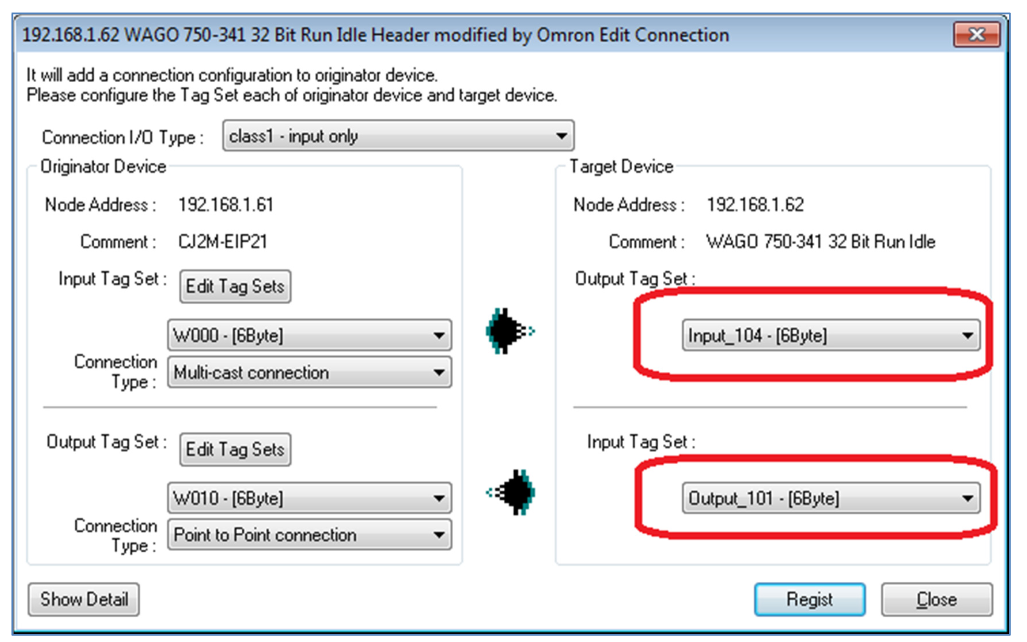
- Using the Network Configurator for EtherNet/IP, select Tools / Setup Parameters. The Network Configurator for EtherNet/IP must be online to select this menu option.

- Using the Setup Parameter tool, read the raw data for each assembly. To read the data, send the messages to the IP Address of the device, using a service of Get Attribute Single. Use Class 4, Instance <Assembly Number in hexadecimal>, Attribute 3. From the example in step 1, Assembly 104 (Instance 68, which is 104 in hexadecimal) and Assembly 101 (Instance 65, which is 101 in hexadecimal) are read.
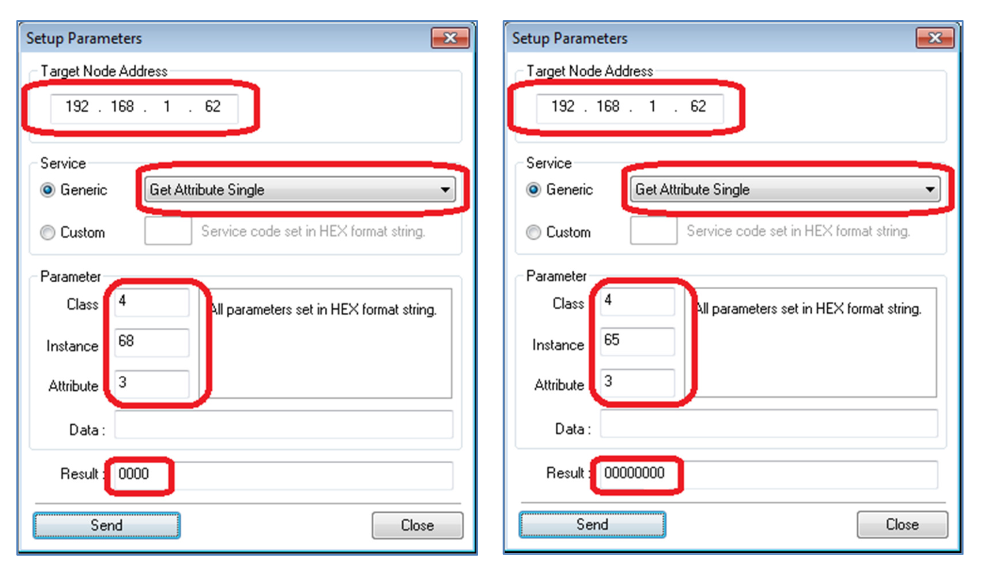
- Count the number of digits received in the Result, and divide the number of digits by 2 to determine the number of bytes. If the response in the Result window is large, highlight the entire Result, and copy / paste into Notepad to facilitate counting the number of digits. In the example above, the response to reading the data from Assembly 104 is 2 bytes long (4 digits) and the response to reading the data from Assembly 101 is 4 bytes long (8 digits).
- Modify the Assembly Size for the device by:
- Right click on the device in the network diagram, and selecting Parameter / Edit.

- Modify the assembly sizes as shown. After modifying the sizes, edit the Tag sizes for the PLC / MAC, modify the Connection to reflect the new sizes, and download to the PLC / MAC.

- Right click on the device in the network diagram, and selecting Parameter / Edit.
- If the above steps do not resolve error code 01:0109, 01:0127, 01:0128 and sometimes 01:031C, try the following to address a specific situation in which the .eds file for the EtherNet/IP device indicates that the product does not use a 32 Bit Run / Idle Header, but the hardware does use a 32 Bit Run / Idle Header. This Run / Idle Header mismatch could be in the produced connection, the consumed connection, or both connections, so there are 3 different combinations to try. See the image on the following page for an example of each of the 3 combinations.
- Add 4 extra bytes to the Produced Data (both the size for the device and the OMRON PLC / MAC Tag).
- Add 4 extra bytes to the Consumed Data (both the size for the device and the OMRON PLC / MAC Tag).
- Add 4 extra bytes to both the Produced and Consumed Data (both the size for the device and the OMRON PLC / MAC tags).
If this does resolve the communication error, the data in the OMRON PLC / MAC will be offset by 4 bytes from the beginning of the PLC tag or memory address. The first 4 bytes will be the 32 Bit Run / Idle header, and should not be used in the PLC / MAC program.
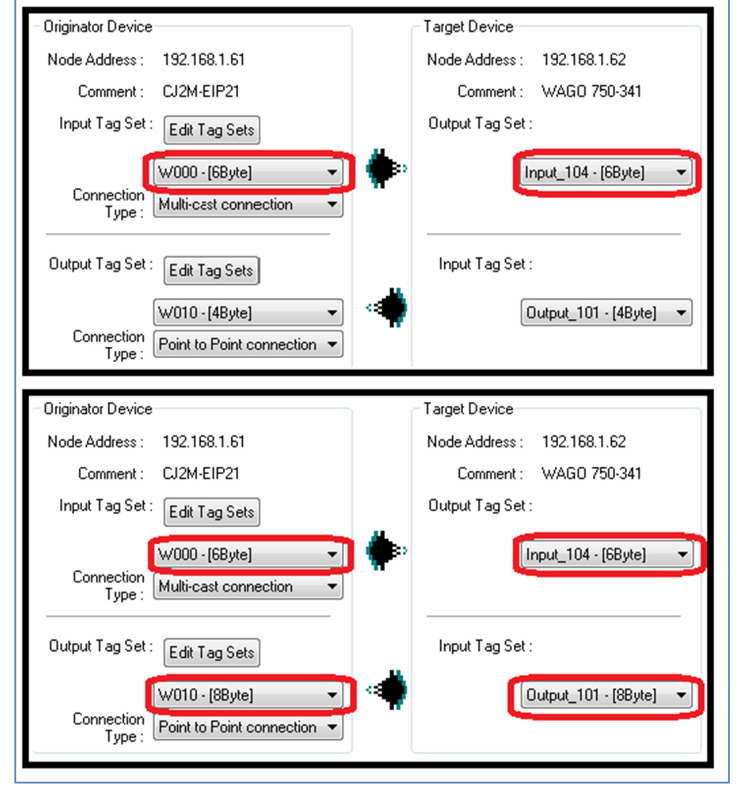
Invalid Produced or Consumed Application Path: 01:0117
Invalid Produced or Consumed Application Path: Error code 01:0117 may be caused by Tag Names used in the Network Configurator for EtherNet/IP or Sysmac Studio that do not exist in the PLC / MAC, do not have the same size in the PLC as in the Network Configurator for EtherNet/IP, or are not marked as network variables in the PLC / MAC.
- Verify that any Tag Names used in the Network Configurator for EtherNet/IP or
Sysmac Studio- Exist in the PLC / MAC, and are spelled correctly.
- Are marked as network variables (Input or Output).
- Are the correct size in the PLC to match the size in the Network Configurator
for EtherNet/IP (in Bytes).
Example from CX Programmer

Example from Sysmac Studio

Other error codes:
Error codes other than those described in section 3 of this document may indicate that additional modifications to the .eds file are necessary, or that the product itself does not comply with the EtherNet/IP specification.
Please contact OMRON and / or the EtherNet/IP device manufacturer for additional support.
5. Other general EtherNet/IP troubleshooting recommendations:
- Use Point to Point connections, instead of Multicast connections. Some devices do not support Multicast connections, or do not implement them properly, and some IT devices block Multicast packets.

- Remove Ethernet switches from the network, and use a crossover Ethernet cable between the PLC / MAC and the EtherNet/IP device.
- Try different Ethernet cables. Ethernet cables degrade with rough use in the field (laptop bags, etc). Also, sometimes cables are over crimped during manufacturing, causing intermittent connections.
- If the Status of the connection as read in section 1 is 00:0000, but the data received from the EtherNet/IP device is always 0 for all bytes received, this may indicate improper implementation of the 32 Bit Run / Idle Header in the EtherNet/IP device.
Contact OMRON Technical Support for assistance removing the Run / Idle Header from the .eds file, and add extra bytes as described in step 6 of section 4 of this document.
Explicit Messaging
1. Reading Explicit Messaging Error Codes
When using Explicit Messaging from an NX / NJ controller, it is possible to look up the response code that a device returned. When the ErrorID on the function block is 1C00, then the ErrorIDEX contains the response code from the device that the message was sent to, such as an inverter, robot, etc. The first 2 bytes of the ErrorIDEx are the error code, byte swapped. For example, 0E00 0000 is error code 0x000E.

2. Explicit Message Error Response Codes (ErrorID = 1C00)
| ErrorIDEx | Description |
|---|---|
| 0x0001 | Connection failure |
| 0x0002 | Resource unavailable |
| 0x0003 | Invalid parameter value |
| 0x0004 | Path segment error |
| 0x0005 | Path destination unknown |
| 0x0006 | Partial transfer |
| 0x0007 | Connection Lost |
| 0x0008 | Service not supported |
| 0x0009 | Invalid attribute value |
| 0x000A | Attribute list error |
| 0x000B | Already in requested mode/state |
| 0x000C | Object state conflict |
| 0x000D | Object already exists |
| 0x000E | Attribute not settable |
| 0x000F | Privilege violation |
| 0x0010 | Device state conflict |
| 0x0011 | Reply data too large |
| 0x0012 | Fragmentation of a primitive value |
| 0x0013 | Not enough data |
| 0x0014 | Attribute not supported |
| 0x0015 | Too Much Data |
| 0x0016 | Object does not exist |
| 0x0017 | Service fragmentation sequence not in progress |
| 0x0018 | No stored attribute data |
| 0x0019 | Store operation failure |
| 0x001A | Routing failure, request packet too large |
| 0x001B | Routing failure, response packet too large |
| 0x001C | Missing attribute list entry data |
| 0x001D | Invalid attribute value list |
| 0x001E | Embedded service error |
| 0x001F | Vendor specific error |
| 0x0020 | Invalid parameter |
| 0x0021 | Write-once value or medium already written |
| 0x0022 | Invalid Reply Received |
| 0x0025 | Key Failure in path |
| 0x0026 | Path Size Invalid |
| 0x0027 | Unexpected attribute in list |
| 0x0028 | Invalid Member ID |
| 0x0029 | Member not settable |
| 0x002A | Group 2 only server general failure |
3. Explicit Message Error Codes (ErrorID != 1C00)
For ErrorID values other than 1C00, see W503 – NJ NX Series Troubleshooting Manual.
A short list of common ErrorIDs is shown below:
| ErrorID | Description |
|---|---|
| 1C01 | Incorrect Route Path |
| 1C02 | CIP Handle Out of Range |
| 1C03 | CIP Communications Resource Overflow |
| 1C04 | CIP Timeout |
| 1C05 | Class 3 Connection Not Established |
| 1C06 | CIP Communications Data Size Exceeded |